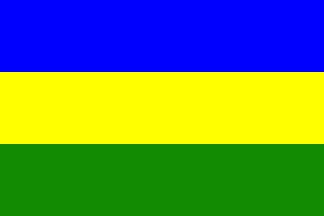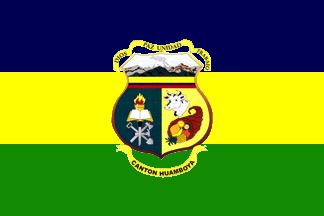 klaus-michael schneider
klaus-michael schneider
Keywords: morona-santiago | morona | santiago | huamboya |
Links: FOTW homepage | search | disclaimer and copyright | write us | mirrors

Last modified: 2021-08-26 by  klaus-michael schneider
klaus-michael schneider
Keywords: morona-santiago | morona | santiago | huamboya |
Links: FOTW homepage |
search |
disclaimer and copyright |
write us |
mirrors
 image by Ivan Sache, 17 September 2018
image by Ivan Sache, 17 September 2018
See also:
Huamboya canton (5,965 inhabitants, 97,100 ha) is located in the north-east
of Morona Santiago province. Huamboya is named for Shuar words meaning "a
floating house".
Huamboya was established on 24 May 1970 as a
pre-cooperative part of the parish of Arapicos (Palora canton). Huamboya canton
was established on 2 January 1992; the parish of Pablo Sexto was subsequently
separated to form a new canton.
http://www.huamboya.gob.ec/
Canton website
Ivan Sache, 17 September 2018
The flag of Huamboya is horizontally divided blue-yellow-green, representing
all the nooks and crannies of the local geography. It shall be flown on all
educational institutes and public and private institutions of each of the
communities composing the canton.
Blue represents the celestial vault of
the clean and clear sky that covers us, as well as the attractive rivers and
lakes that embellish the landscape of our territory.
Yellow represents the
resources provided by the fertile and productive soil and the shining sun that
goes with us every day in a new rise, as well as its ultimate reflections at the
end of the day. Yellow also represents the mining resources that are the fruit
of our development.
Green represents the immense savanna covered with trees,
shrubs, pastures and bushes, and the infinity of orchids that adorn gardens, as
well as the great diversity of birds that enlighten with their song the onset
and end of the day. Green also represents work performed by the natives and the
colonists, proud to see the emergence of new seeds and of green fields that will
provide fruits for the inhabitants.
The coat of arms of Huamboya
represents the greatness, the achievements and the power of the inhabitants.
Such virtues are highlighted in the upper part on the scroll inscribed "DIOS PAZ
UNIDAD TRABAJO" (God Peace Unity Work), symbolically acknowledging God for
having offered this benign land, complemented with unity and work that secure
the people's achievement and hospitality.
Ivan Sache, 17 September 2018
 image by
Ivan Sache, 17 September 2018
image by
Ivan Sache, 17 September 2018
Photo of the flag can be seen at
nyx.cti.espol.edu.ec
(defunct). The flag is dark blue-yellow-green horizontal tri-band
and charged with the Coat of Arms.
Jens Pattke, 15 September 2007
In the upper part of the shield is featured volcano Sangay, the loyal witness
of the inhabitant's aspirations, vows and commitments, as well as a jealous
warden of the natural environment and a watcher of the flora and fauna. Sangay
is a living entity that embellishes and adorns the freshness and purity of the
forest, together with its roaming and smokes which, from time to time, repel the
enemy who would alter the beauty of the landscape.
In the middle part of the
shield is featured the national tricolor flag, crossing the shield from left to
right, as the single flag that can cover all Ecuadorians.
In the lower left
part is featured a torch, meaning wisdom and the light that illuminates the way
in the search of better days, an open book describing knowledge, science and
technology taught to all students.
In the lower right part is represented the
potential of cattle-breeding and agriculture, as the force and sacrifice of the
locals and the foreigners.
Beneath the shield a scroll is inscribed with the
noble and heroic "CANTON HUAMBOYA".
http://www.huamboya.gob.ec/portal/index.php/contenido/item/simbolos-del-canton-huamboya
Canton website
The isolated Sangay volcano, located east of the
Andean crest, is the southernmost of Ecuador's volcanoes and its most active.
The steep-sided, glacier-covered, dominantly andesitic volcano grew within
horseshoe-shaped calderas of two previous edifices, which were destroyed by
collapse to the east, producing large debris avalanches that reached the
Amazonian lowlands. The modern edifice dates back to at least 14,000 years ago.
It towers above the tropical jungle on the east side; on the other sides flat
plains of ash have been sculpted by heavy rains into steep-walled canyons up to
600 m deep. The earliest report of a historical eruption was in 1628. More or
less continuous eruptions were reported from 1728 until 1916, and again from
1934 to the present. The almost constant activity has caused frequent changes to
the morphology of the summit crater complex. This volcano is located within the
Sangay National Park, a UNESCO World Heritage property.
https://volcano.si.edu/volcano.cfm?vn=352090
Global Volcanism Program, Smithsonian Institute
Ivan Sache, 17 September 2018
s-ho.gif)
image from <www.moronasantiago.gov.ec>